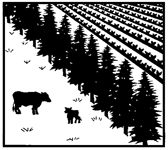U.S. Department of Agriculture: Forest Service -- National Agroforestry Center
Date of this Version
May 1998
Abstract
Technologies are readily available for growing hybrid poplars and willows in block plantings as short-rotation woody crops (SRWC) for fuel and fiber. SRWC species and technologies can also be incorporated into agricultural systems as agroforestry practices. Examples are windbreaks, living snowfences, “timberbelts”, riparian buffer strips, and wastewater treatment plantings. Fast growth, convenient propagation (see AF Note - 11), and compatibility with conventional farming methods make SRWC suitable for use in agroforestry practices to provide multiple benefits such as solid wood and wood fiber products, water quality improvement, crop and soil protection, wildlife habitat, and buffers for agricultural/community interfaces.


Comments
Published by National Agroforestry Center, USDA Forest Service, Rocky Mountain Station, USDA Natural Resources Conservation Service, East Campus – UNL, Lincoln, Nebraska 68583-0822.